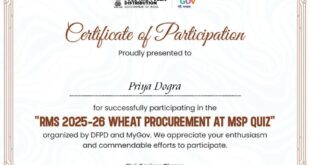Enroll Here: California Institute of the Arts Graphic Design Specialization.
Fundamentals of Graphic Design Coursera Quiz Answers – Week 2 Quiz
Question 1: What is this area of a letterform called?
- Outer Space
- Oval
- Counterspace
- Letter Hole
Question 2: What are the parts of letters that fall below the baseline called?
- Tails
- Descenders
- Ascenders
- Rudders
Question 3: What is the term for this measurement in letterforms?
- Y-height
- X-height
- Cap Height
- a-height
Question 4: What is the term for letter spacing and word spacing combined?
- Trucking
- Tricking
- Tracking
- Type Spacing
Question 5: What is the measurement system for type called?
- Pint size
- Point size
- Lead size
- Inch size
Question 6: What is the term for the setting of a block of text when the left hand and the right hand edges of the text form straight vertical lines?
- Range Right
- Range Left
- Centered
- Justified
Question 7: What is the term for the distance between baselines in a block of text?
- Leading
- Lineage
- Cap height
- X-height
Question 8: Is Bodoni an example of an Old Style, Transitional or Modern serif typeface?
- Transitional
- Old Style
- Modern
Question 9: Is Futura an example of a Grotesque, Geometric, or Humanist sans serif typeface?
- Grotesque
- Geometric
- Humanist
Question 10: What very popular type family is shown here?
- Helvetica
- Bodoni
- Times
- Caslon
Fundamentals of Graphic Design Coursera Quiz Answers – Week 3 Quiz
Question 1: What is the name for images that are simplified, pictorial representations of actual things, like the two images shown above?
- Symbols
- Icons
- Iconoclasts
- Buttons
Question 2: What is the name for images that are non-pictorial representations of ideas or concepts, like the two images shown above?
- Pictures
- Icons
- Symbols
- Concepts
Question 3: In the figure/ground image shown above, are the white objects the figure or the ground?
- Figure
- Ground
Question 4: In the color wheel, what is the term used to describe colors that sit next to each other?
- Classmates
- Gradations
- Complementary
- Analogous
Question 5: In the color wheel, what is the term used to describe colors that sit directly OPPOSITE to each other?
- Complementary
- Analogous
- Enemies
- Oppositional
Question 6: What is the term used to describe the color system used for on-screen color, shown above?
- CMYK
- LAB
- Rainbow
- RGB
Question 7: What is the term used to describe the color created when you mix two primary colors?
- Secondary
- Primary
- Complimentary
- Mid-tone
Question 8: What is the term used to describe the color system used in 4-color printing, shown above?
- RGB
- Spot color
- PMS
- CMYK
Question 9: Color can be controlled with changes to Hue, Saturation and Value. Which one of these is shown above?
- Saturation
- Value
- Hue
Question 10: What was the name of the influential German art school where Johannes Itten taught visual contrasts in shapes and forms in the early 1920s?
- Neuehaus
- CalArtz
- Bauhaus
- De Stijl Haus
Introduction to Typography Coursera Quiz Answers – Week 1 Quiz
Question 1: The lines that form letters are called:
- strokes
- paths
- splines
Question 2: The wedge-shaped forms at the ends of some letterforms are called:
- ligatures
- serifs
- stumps
Question 3: The x-height describes:
- the height of an uppercase ‘x’.
- the height of a lowercase ‘x’
- the midpoint of an uppercase ‘x’
Question 4: A ____________ is what a line of text sits on.
- body
- leading
- baseline
Question 5: The part of a letterform that extends below the baseline is called a:
- descender
- ligature
- tail
Question 6: Type is measured in:
- agates
- millimeters
- points
Introduction to Typography Coursera Quiz Answers – Week 1 Quiz
Question 1: Which quality does not apply to this typeface?
- Heavily Modulated
- Sans serif
- Vertical axis
Question 2: Which quality does not apply to this typeface?
- Heavily Modulated
- Sans serif
- Vertical axis
Question 3: Which quality does not apply to this typeface?
- Heavily Modulated
- Sans serif
- Vertical axis
Question 4: What is this part of a letterform called?
- Donut hole
- Counter
- Bullet hole
Question 5: What is this part of a letterform called?
- Goose neck
- Spur
- Ascender
Question 6: What is this part of a letterform called?
- Terminal
- Bulb
- Ligature
Question 7: What is this line?
- x-height
- Water line
- Baseline
Question 8: What does this notation mean?
- 6 points cubed
- 6 picas and 3 points
- 6 pages times 3
Question 9: An em space is defined by:
- The point size of the typeface
- The width of an M&M
- 3 picas
Question 10: Which of these styles of type is conventionally seen as more suitable for text settings?
- Dingbats
- Sans serif type
- Serif type
Ideas from the History of Graphic Design Coursera Quiz Answers – Week 1 Quiz
Question 1: What was a curious or unprecedented outcome of mass production during the Victorian era? (Hint: there are 2 correct answers to this question; you must select both to earn full marks.)
- Despite the modernization of production techniques, a lot of vernacular design still looked a lot like the handcrafted objects of the past.
- In the last two decades of the 19th century, the production of wooden household goods surpassed metal and ceramic goods combined.
- Popular taste was influenced by content broadcast over shortwave radio, an emerging technology of the time.
- It was poor design, poor salesmanship and consumer demand for low-price goods that flooded the market with “bad” or shoddy goods, not mechanization itself.
Question 2: What does the term “form follows function” mean? (Choose the best answer.)
- It is important to understand how an object is used so we can classify it and give it value.
- It isn’t necessarily important how an object looks; what matters is how it is used.
- The form of an object is an indication of how it was created (or used).
Question 3: What was the primary reason for the range of “revival” styles in furniture and household goods of the Victorian period?
- Applying a historic style created a commercial familiar language to appeal to the tastes and values of various many consumers.
- The appropriation of Classical styles made things look “classy”.
- Herter Brothers were popular and this was the style of furniture they sold.
Question 4: What was the primary reason that manufacturers adopted logos for their products?
- It was necessary to mark boxes and crates on ships for taxation purposes.
- Since goods were manufactured and then shipped, companies needed a way to mark their product for merchants distributing their product locally.
- Every product needs a logo for marketing purposes.
Question 5: How did companies in the 19th century reconnect consumers to their mass-produced goods? Choose the best answer.
- They used the likenesses of the company owners or product inventors on the product packaging.
- They advertised the products using long narratives to describe the product, how to use it, and why you needed it.
- They used fictional characters as product branding to create an emotional attachment between the consumer and the product.
- All of the above.
Ideas from the History of Graphic Design Coursera Quiz Answers – Week 2 Quiz
Question 1: What answer best describes the intention of the Bauhaus?
- Educating design students for the 20th century
- Positing that the fields of art, architecture and design had equal status.
- Opening up a connection between culture and a society framed by mass production and communication.
- All of the above.
Question 2: In what crucial way did the Bauhaus differ from a traditional art education?
- The Bauhaus students learned basic draftsmanship skills by drawing a lot, and specialized after their formal education through a working apprenticeship.
- The Bauhaus students started their education with a Foundation Year, permitting experimentation with all materials, before specializing with an apprenticeship in school.
- Learning took place through lectures about working with materials.
Question 3: What did Walter Gropius determine was the core discipline of the Bauhaus education?
- Architecture
- Graphic Design
- Textiles
- Material Studies
Question 4: What was a key characteristic of some of the crafted objects, such as ceramics, produced by students of the Bauhaus?
- They were objects intended for mass manufacture but had the same level of craft that traditionally went into one-of-a-kind objects applied to them.
- They were composed solely of simple or Platonic forms.
- They were made from sustainable materials collected locally or from the discarded artwork of their peers.
Question 5: What is a key component of some of the typefaces designed at the Bauhaus?
- Modularity
- Simplicity
- Machine-made appearance
- Geometric
- All of the above
Ideas from the History of Graphic Design Coursera Quiz Answers – Week 3 Quiz
Question 1: What description best fits the approach used by American Modern designers during this period?
- Long narratives written by a fictional consumer.
- Portraits of the manufacturers.
- A complex symbolic language.
- A combination of words and text.
Question 2: Of the four designers presented in this module, which designer would be best described as taking a subjective approach to design?
- Lester Beall
- Alvin Lustig
- Paul Rand
- William Golden
Question 3: Of the four designers presented in this module, which designer would be best recognized for creating a comprehensive, recognizable vision for a new media enterprise?
- Paul Rand
- Alvin Lustig
- Lester Beall
- William Golden
Question 4: Of the four designers presented in this module, which designer would be best described as recognized for incorporating old forms and new?
- Lester Beall
- Alvin Lustig
- Paul Rand
- William Golden
Question 5: Of the four designers presented in this module, which designer would be best described as incorporating simple imagery and sometimes playfulness to powerful ends?
- Lester Beall
- Alvin Lustig
- Paul Rand
- William Golden
Ideas from the History of Graphic Design Coursera Quiz Answers – Week 4 Quiz
Question 1: What are some of the key aspects of Swiss Design? (Hint: there are 4 correct answers.)
- Rational
- Ornate
- Sans-serif typography
- Expressive
- Serif typography
- Abstract
- Privileged photography over hand-drawn illustrations
- Adhered to grid
Question 2: Why was Swiss Design so appealing to American companies in the 1960s?
- Its straightforward appearance wasn’t connected to any national identity, which created a universal brand for companies with an international reach.
- Its uncomplicated appearance made it easy and inexpensive to reproduce.
- Customers perceived it as more trustworthy
Question 3: What exactly were the designers from San Francisco’s Haight district doing with their super-saturated, day-glo posters of the late 1960s?
- They were using a visual language that appealed to an audience of rock fans who were not unfamiliar with experimental drugs and experiences of the period.
- They obfuscated the written content of the poster by using very expressive type layout.
- They borrowed from the past frequently, incorporating historic images and type into the layout.
- All of the above
Question 4: The Diggers produced broadsides and flyers that were hastily designed (often hand-drawn) and printed using inexpensive techniques. Why? (Hint: there are 2 correct answers.)
- The better print shops refused to the “hippie” messages
- The anti-establishment aesthetic resonated with the countercultural groups in San Francisco at the time
- It permitted the designers to iterate quickly and get their message out to the public.
- It was a popular aesthetic of the time.
Question 5: In Sister Corita’s eyes, what is the fundamental connection between a street protest and a printed advertisement? Choose the best answer.
- Both used bright, saturated colors.
- Both used text styled as headlines
- Both had high potential for visibility within a very large audience.
- Both were recognized as powerful cultural agents.
 Priya Dogra – Certification | Jobs | Internships
Priya Dogra – Certification | Jobs | Internships



